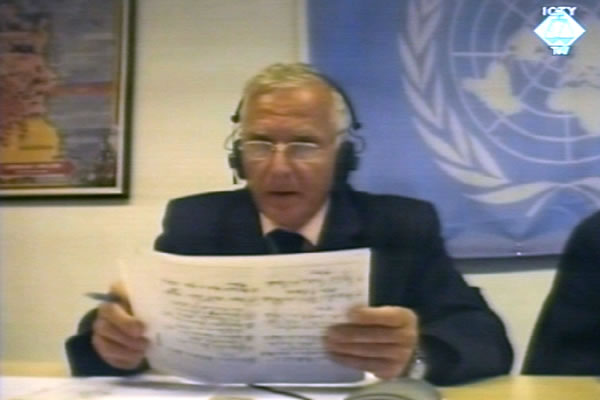Home
1,163 RESIDENTS OF KLJUC DETAINED IN MANJACA: FEW OR MANY?
At the trial of Radovan Karadzic the prosecution continued calling evidence about the crimes of the Serb forces in BH municipalities. Atif Dzafic, former police commander in Kljuc, testified via video link. In 1992, Dzafic was detained for about seven months in the Manjaca prison camp. Karadzic contends that ‘only’ 1,163 out of 17,000 Bosniaks living in Kljuc before the war were detained in the camp
 Atif Dzafic, testifying by video link at the Radovan Karadzic trial
Atif Dzafic, testifying by video link at the Radovan Karadzic trial The cross-examination of Nusret Sivac continued today at Radovan Karadzic’s trial. In the face of the prosecutor’s objections and repeated warnings by the judges, Radovan Karadzic kept asking him questions about what he wrote in his book, The Small Town of Prijedor, which has not been admitted into evidence. Karadzic didn’t ask the witness about the transcript of his previous testimony, which is in evidence. Since Karadzic didn’t challenge any of the claims Sivac made in his previous testimony about the events in Prijedor and the Omarska prison camp where he was detained, prosecutor Edgerton did not need to re-examine the witness at all.
After Nusret Sivac completed his evidence, Atif Dzafic took the stand via video link. Dzafic is former commander of the Public Security Station in Kljuc. On 21 May 1992, Dzafic was dismissed because he refused to sign a declaration of loyalty to the Serb authorities. The witness was detained in the Nikola Mackic School in Kljuc and was then moved to the Manjaca prison camp. He was released in mid-December 1992 and was transported in a convoy with other prisoners to Karlovac, in Croatia.
The transcript of the witness’s testimony at the trial of Mico Stanisic and Stojan Zupljanin was admitted into evidence. At that trial, the witness described how the prisoners were beaten, made to do forced labor, had inadequate food and were held in inhumane conditions in the so-called ‘stables’ in the Manjaca prison camp. About 1,110 non-Serbs from Kljuc went through this facility.
In addition to Manjaca, the witness testified in his previous evidence about two other incidents listed in the indictment against Karadzic: the killing of at least 77 persons in a school in Velagici on 1 June 1992 and the massacre of 144 Bosniaks in Biljani on 10 July 1992. Kljuc is one of the eight BH municipalities where the ethnic cleansing of non-Serbs reached the scale of genocide, as the prosecution alleges.
In the cross-examination, Karadzic contested the witness’s entire evidence, insisting that only a small number of non-Serbs had been detained in Manjaca: ‘only’ about 1,100 of the 17,000 non-Serbs living in Kljuc before the war. The witness retorted that the non-Serbs from Kljuc were detained in other detention facilities, not just in Manjaca.
Karadzic also tried to argue ‘there were reasons’ why the witness was arrested. As Karadzic said, one of the Muslim detainees said in his statement that Dzafic ‘trained the extremists and covered up their activities’ and was suspected of the murder of a Serb colleague.
The witness dismissed these claims of the accused, noting that he would surely have been killed in Manjaca, had there been any truth to Karadzic’s accusations. As for whether the arrest and detention of the other Kljuc residents were justified, the witness repeatedly said that there were many women and children, including babies, in the mass graves in the Kljuc area. They were recovered from the mass graves that also contained the remains of the male victims. After the war the witness took part in the exhumations.
The trial of Radovan Karadzic for genocide and other crimes in the war in BH continues on Monday, 3 October 2011.
